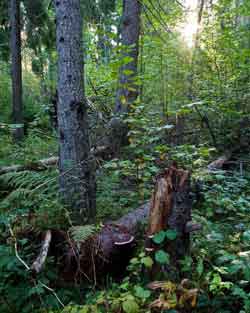Mixed forests – a missed opportunity?

Image: Mixed forrest outside Uppsala, Sweden.<br>Photo:Nic Kruys/N<br>
Modern forestry is largely based on monocultures—in Sweden usually pine or spruce—mainly because it is considered more rational. However a forest contributes more ecosystem services than timber production, such as biological diversity, carbon storage, and berries.
A new study from the Swedish University of Agricultural Sciences (SLU) and Future Forests shows that mixed forests, in comparison with monocultures, have positive effects on several different services, including production.
“Many people have suggested that high diversity of tree species has a favorable impact on processes in the ecosystem, but until now this connection has primarily been studied in terms of one process or ecosystem service at a time,” says Lars Gamfeldt from University of Gothenburg, who directed the new study.
The study, performed by an international research group, is based on material from the Swedish National Forest Inventory and the Swedish Forest Soil Inventory.
By examining the role played by the occurrence of diverse tree species for six different ecosystem services (tree growth, carbon storage, berry production, food for wildlife, occurrence of dead wood, and biological diversity), the study demonstrates that all six services were positively related to the number of tree species.
Different trees contribute to different services. For example, the amount of spruce is related to high tree growth and the amount of pine to berry production, while carbon storage was found in plots with more birch. In order to attain more of all services, forestry may thus need to make use of different tree species. Other studies of forests in Central Europe, the Mediterranean region, and Canada support these findings.
The study also investigated the relationship between the various ecosystem services. For example, high tree growth appears to be negatively related to the production of both berries and food for wildlife and to the occurrence of dead wood. On the other hand, food for wildlife was positively associated with both berry production and biological diversity in ground vegetation.
“It’s not so simple that you can always get more of everything. Sometimes you have to consider trade-offs between different ecosystem services,” says Jon Moen from Umeå University.
The new study, which is published in the scientific journal Nature Communications, runs partly counter to conventional thinking in forestry in Sweden. According to 2011 data from the Swedish National Forest Inventory, only about 7.5 percent of the productive forest land has mixed forests.
“Our findings show that both forestry and nature conservation stand to gain by promoting a greater variety of tree types, thereby providing more diverse ecosystem services,” says Jan Bengtsson, from the Swedish University of Agricultural Sciences.
Contacts:
Jan Bengtsson, SLU, mobile: +46 (0)70-2335118, jan.bengtsson@slu.se
Jon Moen, Umeå University, mobile: +46 (0)70-2271513, jon.moen@emg.umu.se
Lars Gamfeldt, University of Gothenburg, mobile: +46 (0)70-3393921, lars.gamfeldt@gu.se
The Future Forests Research Programme is a collaboration between the Swedish University of Agricultural Sciences (SLU), Umeå University, and Skogforsk and is funded by Mistra, SLU, Umeå University, Skogforsk, and the Swedish forestry industry.
Full bibliographic information”Higher levels of multiple ecosystem services are found in forests with more tree species”
Lars Gamfeldt, Tord Snäll, Robert Bagchi, Micael Jonsson, Lena Gustafsson, Petter Kjellander, María C. Ruiz-Jaen, Mats Fröberg, Johan Stendahl, Christopher D. Philipson, Grzegorz Mikusiński, Erik Andersson, Bertil Westerlund, Henrik Andrén, Fredrik Moberg, Jon Moen & Jan Bengtsson
Nature Communications 4, Article number: 1340, doi:10.1038/ncomms2328
Media Contact
All latest news from the category: Agricultural and Forestry Science
Newest articles

A universal framework for spatial biology
SpatialData is a freely accessible tool to unify and integrate data from different omics technologies accounting for spatial information, which can provide holistic insights into health and disease. Biological processes…

How complex biological processes arise
A $20 million grant from the U.S. National Science Foundation (NSF) will support the establishment and operation of the National Synthesis Center for Emergence in the Molecular and Cellular Sciences (NCEMS) at…

Airborne single-photon lidar system achieves high-resolution 3D imaging
Compact, low-power system opens doors for photon-efficient drone and satellite-based environmental monitoring and mapping. Researchers have developed a compact and lightweight single-photon airborne lidar system that can acquire high-resolution 3D…





















